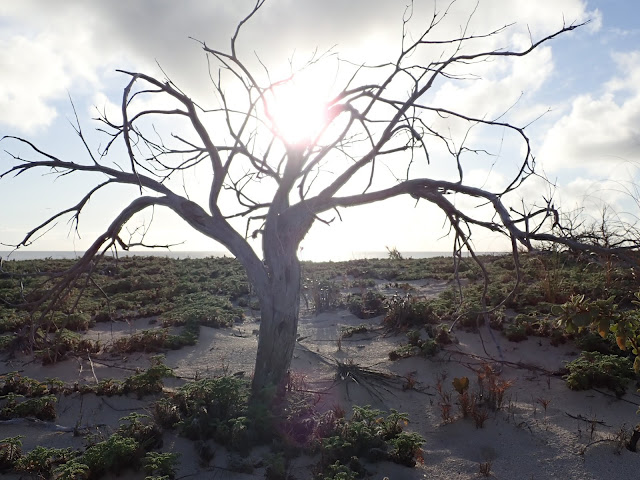Pictures and reflections - West Plana Cay
After we spent a week waiting out a storm on Mayaguana, we sailed to West Plana Cay. After being a little under-whelmed by Mayaguana, West Plana was beautiful and wild and adventurous. There are no regular human inhabitants, but there was evidence that humans come intermittently - there are several deserted lean to's and shelters that show ongoing human use. There were also several ship-wrecks, including a commercial fishing boat.
The island also has a large population of goats, and a local on another island told us that this is why people go there regularly - to hunt the goats. He explained that putting a herd of animals on an island was much more convenient than trying to create a fenced-in pasture for livestock on a bigger island. People also go there for the intermittent harvest of cascarilla bark (used to flavor Campari and vermouth).
This island had an AMAZING beach - broad with pristine coarse white sand. It sloped up to a natural berm, and after climbing that, you could see the interior of the island, which was full of arid caribbean foliage including tons of short fan palms (these were small, most 5-10 feet), and lots of succulents. There were also three salty lagoons - two were brackish and smelly, but the last had really clear water. There were animal trails throughout the entire island (peppered with goat pellets) and this made it easy to walk throughout the interior.
Finding the previously used human camps as well as a goat trap was sort of spooky - it felt like maybe there was someone still there, or maybe it was the sort of place you could find a body (this is my over-active imagination). But it was also such a beautiful island that felt like it was on the edge of the world. If there is ever an apocalypse, we want to do the Swiss family Robinson thing on this island.
The island also has a large population of goats, and a local on another island told us that this is why people go there regularly - to hunt the goats. He explained that putting a herd of animals on an island was much more convenient than trying to create a fenced-in pasture for livestock on a bigger island. People also go there for the intermittent harvest of cascarilla bark (used to flavor Campari and vermouth).
This island had an AMAZING beach - broad with pristine coarse white sand. It sloped up to a natural berm, and after climbing that, you could see the interior of the island, which was full of arid caribbean foliage including tons of short fan palms (these were small, most 5-10 feet), and lots of succulents. There were also three salty lagoons - two were brackish and smelly, but the last had really clear water. There were animal trails throughout the entire island (peppered with goat pellets) and this made it easy to walk throughout the interior.
Finding the previously used human camps as well as a goat trap was sort of spooky - it felt like maybe there was someone still there, or maybe it was the sort of place you could find a body (this is my over-active imagination). But it was also such a beautiful island that felt like it was on the edge of the world. If there is ever an apocalypse, we want to do the Swiss family Robinson thing on this island.
 |
| Approaching West Plana Cay |
 |
| The beautiful beach at West Plana. That is our boat in the distance. |
 |
| Jack walking the beach |
 |
| Jack and Fox playing make-shift golf on the beach. Every shot is from a sand trap. |
 |
| Looking into the island's interior. Look closely - there is a goat in the center of the picture. |
 |
| Daisy finds a sliver of shade. |
 |
| Turning garbage into found art. |
 |
| Someone else's garbage art. |
 |
| Nature is slowly reclaiming this boat. |
 |
| Spooky make-shift camp. No one there, but definite signs that someone was there within the last few weeks. |
 |
| Off leash and loving it. |
 |
| Salty lagoon, with lesser heron wading in it. |
 |
| Finding a goal skull in the shallows of the clear lagoon. |










Comments
Post a Comment